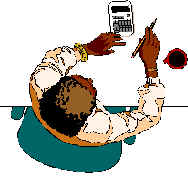HOW
A BILL BECOMES A LAW IN VIRGINIA
|
STEPS DEPICT THE NORMAL PROCEDURE WHEREBY A NON-CONTROVERSIAL BILL BECOMES A LAW. BILLS MAY ORIGINATE IN EITHER THE HOUSE OF DELEGATES OR THE SENATE (Click Here for a pictorial explanation in steps in making a bill) Delegate Accomack Lee, as requested by constituents, prepares
to introduce legislation permitting the governing bodies
of localities to prohibit the sale of certain fireworks. Delegate Lee then explains exactly the proposal he has in mind to a staff attorney in the Division of Legislative services. The staff attorney checks existing law and the constitutionality of the proposed legislation. A bill is drafted by the Division of Legislative Services. Draft copies of the bill are made and delivered to delegate Lee Delegate Lee signs his name on the bill and introduces
it by laying the original and duplicate copies on the
desk of the Clerk of the House of Delegates .The bill is ordered printed an referred to the Committee on Counties, Cities and Towns. The members of the Committee on Counties Cities and Towns - In open session-familiarize themselves with the bill and decide to approve it without amendments The Committee then reports the bill favorably to the house. First Reading: The bill title is printed in the calendar or is read by the Clerk, and the hill advances to second reading. Second Reading: The next day the bill title appears in the printed calendar on second reading. Bills are considered In the order in which they appear on the calendar. The Clerk reads the title of the bill a second time. A bill on second reading is amendable. The bill is explained by its patron (Delegate Lee) who answers any questions that may be asked. By voice vote the House votes advance the bill to third reading. A bill that has passed second reading with or without amendments Is engrossed. If amendments are adopted the bill is reprinted in its final form for passage. Third Reading: The next day the engrossed hill title appears In the House calendar on third reading. The bill is read by title a third time by the Clerk. By recorded roll call vote the bill is passed by the House of Delegates. Communication: When passed, the bill is sent to the Senate either by the Clerk in a communication or by a member in person, informing the Senate that the bill has passed the House and requesting the concurrence of the Senate.In the Senate: The bill goes through substantially the same procedure as it did in the House. The bill is read by title a first time, referred to a standing committee, considered and reported by the committee, read a second time and a third time before passage by a constitutional majority. After the bill has been passed by both
houses of the General Assembly:It is printed as an
enrolled bill, examined and signed by the presiding
officer of each house. Bills enacted at a regular session (or the reconvened session which follows) are effective the 1st Day of July following adjournment of the regular session, unless another dale Is specified. Bills enacted at a special session (or reconvened session) are effective on the 4th month following the adjournment of the special session, unless another date is specified. The General Appropriation Act Is usually effective JULY 1st Source: Reprinted with permission of the Virginia Chamber of Commerce. |


 Then
the bill is sent to the Governor for his approval.After
being signed by the Governor, the bill is sent to
the Clerk of the House (Keeper of the Rolls of the
State) and is assigned a Chapter number. All Chapters
of a session are compiled and bound as the Acts of
Assembly.
Then
the bill is sent to the Governor for his approval.After
being signed by the Governor, the bill is sent to
the Clerk of the House (Keeper of the Rolls of the
State) and is assigned a Chapter number. All Chapters
of a session are compiled and bound as the Acts of
Assembly.